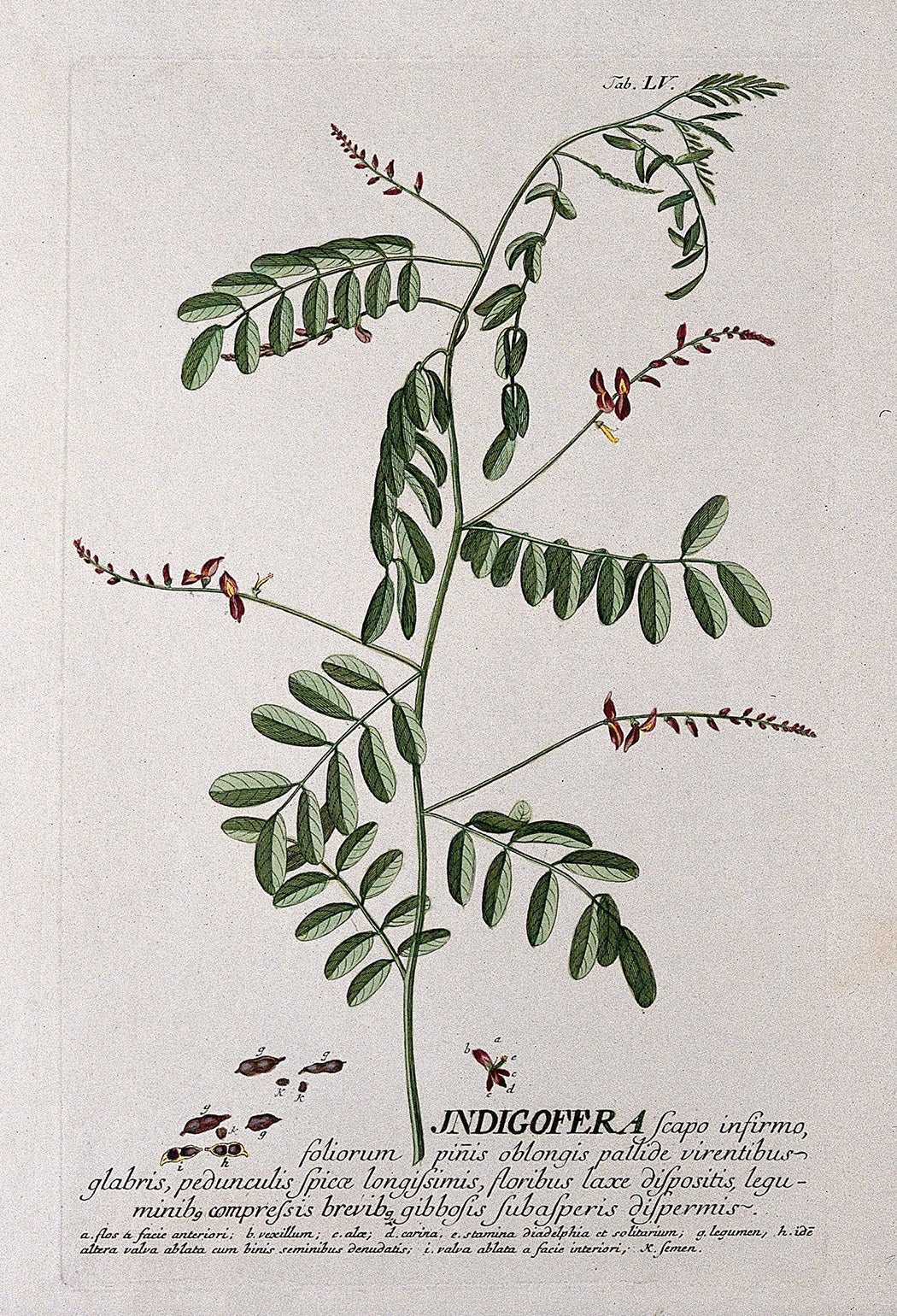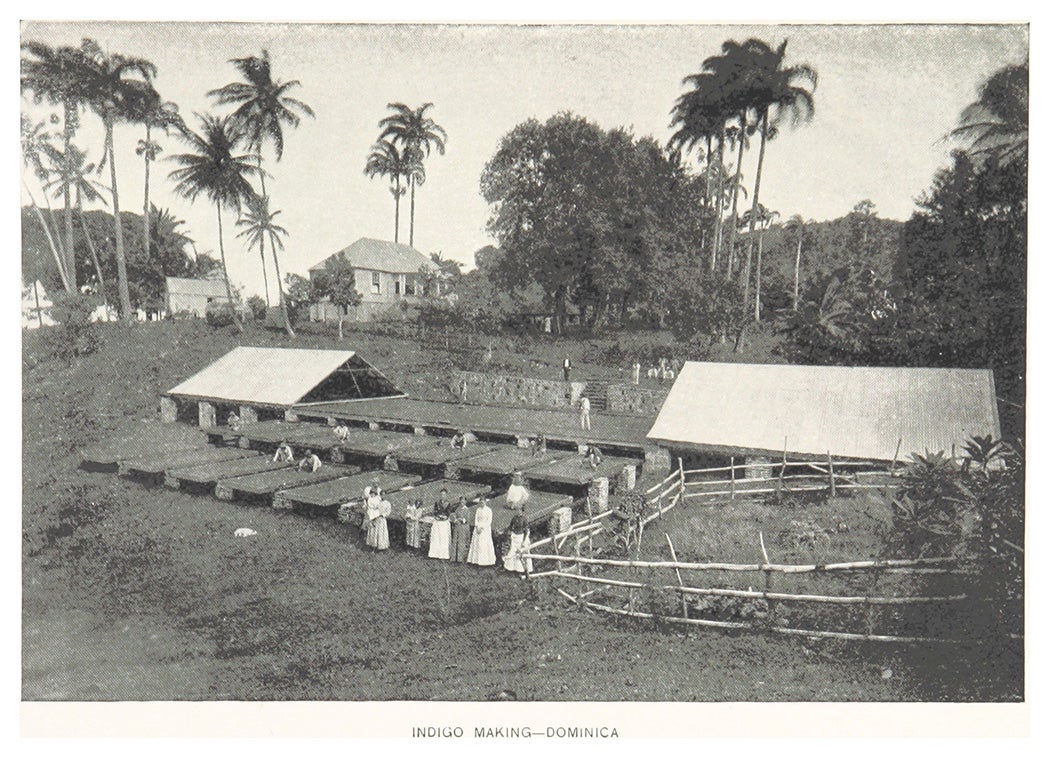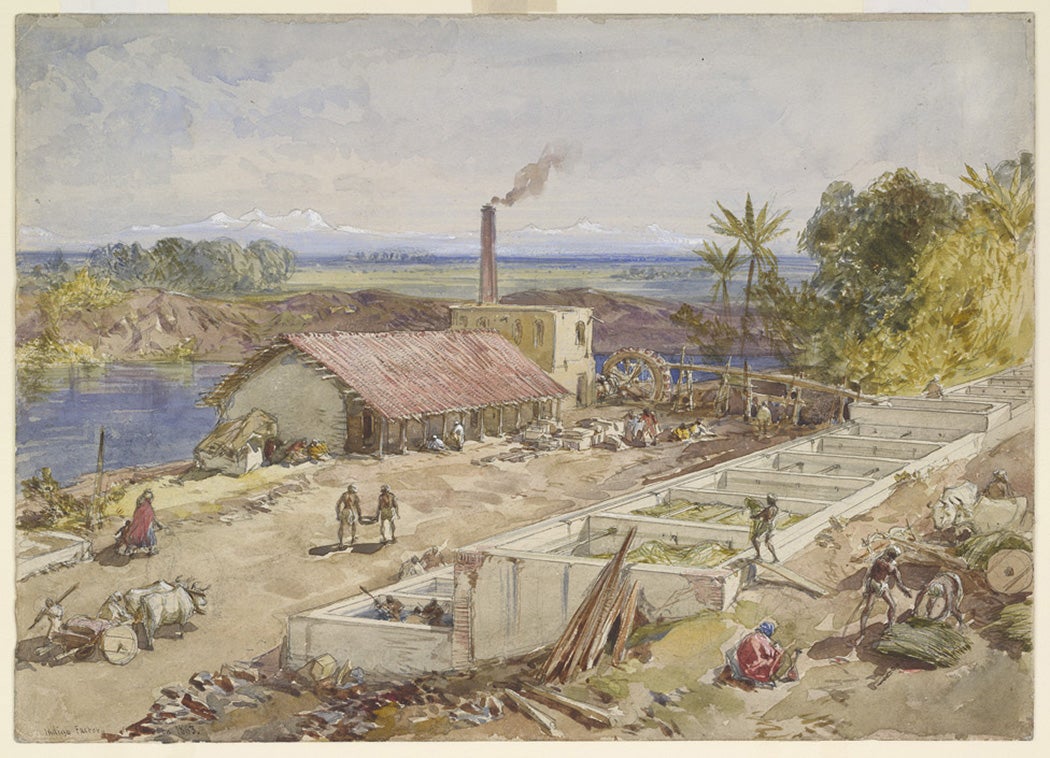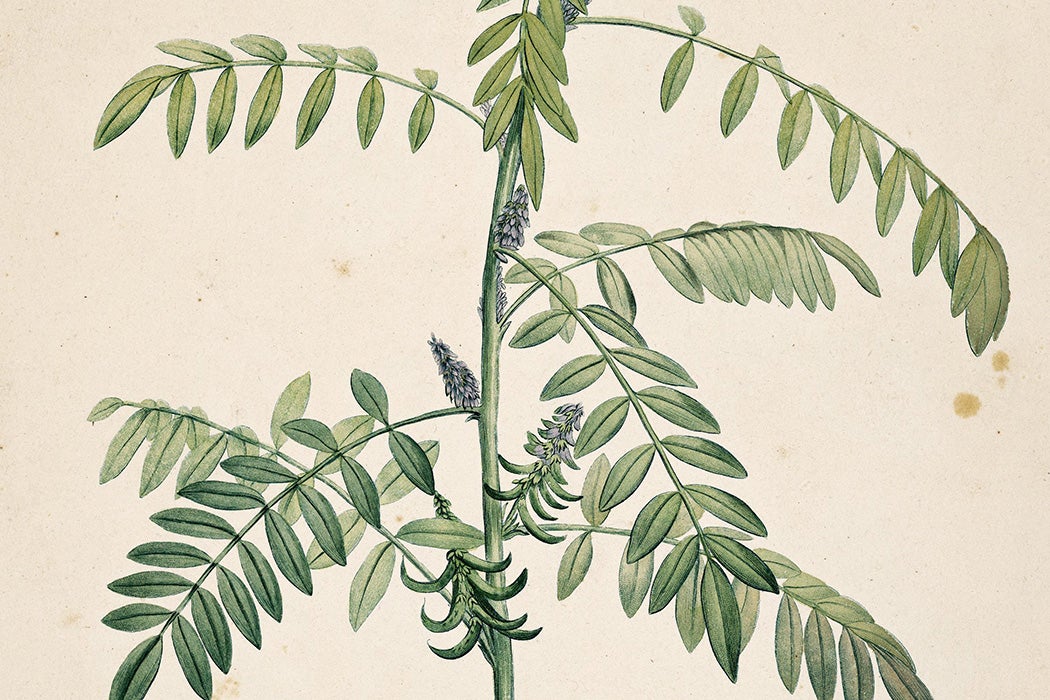In December 2022, the world’s leading denim brand, Levi Strauss & Co., reportedly invested more than four million dollars in Stony Creek Colors, a regenerative agriculture firm that grows indigo, the original plant source of the blue dye that has made denim jeans recognizable across the globe. The partnership, which has attracted media attention over the past few years, should promote sustainable plant-based indigo dyes that will reverse the toxic effects of the carbon-intensive production of synthetic dyes that currently dominate the market. But while companies like Levi Strauss now seek to partner with sustainable agricultural projects, the story of indigo cultivation has not always been one of environmental preservation and care. Instead, for many centuries, the cultivation of indigo was a prime example of colonial exploitation.
Indigo plants are natural sources of blue dye used in art and textiles across civilizations. Indigo’s use as a pigment for painting has been documented in ancient Egypt as well as the Greek and Roman empires. Closer to modern times, in the thirteenth century, Marco Polo reported its use in India, and in the centuries that followed, its cultivation was primarily influenced by the interests and profiteering of European settlers. Thus, the dye extracted from indigo, referred to as blue gold, once a symbol of power and prosperity as the color of royal garments thanks to its malleability, eventually became the staple hue in the British textile industry, used ubiquitously from denim to military uniforms and everything in between.
The genus Indigofera, belonging to the bean family, is native to the tropics and comprises more than 750 species. Many of these species can grow up to six feet tall and are distinguished by their oval-shaped, pinnate leaves. In the Indian subcontinent, the dominant species is Indigofera tinctoria, also known as “True Indigo,” while Indigofera suffruticosa, “West Indian Indigo” or “Guatemalan Indigo,” is prevalent in Central and South America. Indigo is a legume, which means that it can fix nitrogen in the soil, and therefore, it’s used as a rotation crop in agriculture to improve soil quality (which explains its prominent role in sustainable agricultural projects today). The dye extraction is done by fermenting the Indigo leaves, which results in a blue paste.

The genus was first named by the Swedish botanist Carl Linnaeus (1707–1778) in his groundbreaking treatise Species Plantarum (1753). Still, the use of indigo-dyed fabrics has been extensively documented throughout human history, spanning several millennia and across different cultures. Although scholars believe that the plant’s earliest use emerged in the Near East region, archaeological evidence of the oldest indigo-dyed fabric was found in Huaca Prieta, Peru, one of the first human settlements in the Americas, and dates back 6000 years ago. There are records indicating that indigo-dyed bands were used in Egyptian textiles during the Fifth Dynasty (ca. 4400 BCE), as well as early examples of indigo use in China around 3000 BCE. More recently, cultural historian Kassia St. Claire describes indigo-dye as a luxury item imported from India to the Mediterranean by Arab merchants. In fact, India was the primary supplier of indigo to Europe during the Graeco-Roman period.
In the Americas, indigo was cultivated long before the arrival of Europeans; it was highly valued for its use in art and the textile industry. In the Andean region, the Incas cultivated indigo as a dye for their textiles, body paint, and decorating pottery. Meanwhile, as Dean E. Arnold explains, the Mayans created their own special dye by mixing the product of fermenting indigo-leaves with palygorskite, a type of clay. This color, known as “Maya Blue,” was widely used on sculptures, pottery, and murals. It was also adopted by the Aztecs, who used it to dye highly prized fabrics, including the emperor’s cloak. In his sixteenth-century Historia general de las cosas de la Nueva España (also known as the Florentine Codex), the Spanish friar Bernardino de Sahagún (c. 1499–1590) documented the Aztec use of many plant-based colorants, including an herb named xihuiquilitl, which bore “a dark and shiny kind of blue, which is very precious.” Xihuiquilitl has subsequently been identified as Indigofera suffruticosa. According to Arnold, in addition to a dye source, Aztecs considered Indigo a medicinal plant and used it to treat various ailments, such as fever, urinary diseases, ulcers, and syphilis.
David H. Rembert, Jr. explains that when the Spanish arrived in the Americas and realized that Indigenous people already used indigo as a dye, they saw its large-scale production as a commercial opportunity to displace Portugal’s role in the indigo trade into Europe from the East. As a result, indigo was first imported into Europe from modern-day Guatemala as early as the sixteenth century. By the eighteenth century, the Spanish had established their most extensive indigo plantations in Guatemala, Venezuela, and Mexico. Meanwhile, the French and the English joined them in spreading indigo cultivation to the Caribbean, along with other crops such as rice and cotton, with modern-day Haiti and Jamaica as their primary production sites, respectively. To do this, European settlers relied heavily on the enslaved labor of African and Indigenous peoples, whose knowledge of indigo cultivation and processing was instrumental in developing it as a cash crop.

Indigo spread throughout the southern United States during the eighteenth century as well, and South Carolina became the center of the Indigo trade due to the temporary decline of the colony’s major staple—rice. The profits from indigo quickly outnumbered those of sugar and cotton, and indigo became one of the fastest-growing components of the Atlantic economy, with its total European imports from America increasing six-fold from the mid-1720s toward the end of the century. Its cultivation became so important that, according to Catherine McKinley, indigo textiles were used to weave the first United States flag, and indigo cakes were even used as currency at the time of the Revolutionary War.
After the end of the war, when the British retreated from the American colonies, the planters saw India as another endless source of cheap labor and commodities. Indigo was native to the region, and, as art historian Romita Ray explains, the English East India Company experimented with it in the Calcutta Botanical Garden, established in 1787, to turn it into a useful, commodified plant. As in the Americas, economic botany in India drew and profited from Indigenous knowledge. Especially in the Bengal region, plantations thrived due to the warm and humid climate and abundant riparian ecosystems (zones surrounding rivers and streams favorable to plant life). In this context, Indian farmers were recruited as indentured laborers under a bonding contract known as the Neel system (neel meaning “blue” in Bengali, a reference to the indigo dye) and barred from growing any other crops under the penalty of being heavily taxed. The cultivated indigo was then sold to British planters at below-market rates.
Farmers rebelled against these exploitative practices during the Indigo Revolt of 1859, led by the Biswas brothers in Bengal, turning plantations into what Romita Ray calls “unruly landscapes.” Historians have argued that the revolt was a powerful, non-violent uprising consisting mainly of coordinated protests and petitions, and it brought the British colonial administration to investigate the abuses of indigo planters. Released in 1860, the Report of the Indigo Commission found that the British planters had engaged in various exploitative practices, including using force and fraud to compel Indian farmers to grow indigo. This conclusion was bolstered by testimonies offered in the Report by the involved parties. For example, E. W. L. Tower, magistrate of the city of Faridpur, testified that “not a chest of indigo reached England without being stained with human blood.”
Moreover, farmers interviewed for the Report denounced their labor conditions. Nafar Das claimed he had been deprived of any profit by “coercion and fraudulent commutation” of his produce; Haji Molla stated that he would rather “beg than sow Indigo” under a contract. Following the Commission’s findings, the British government passed the Indigo Commission Act in 1860, eventually abolishing the Neel system.

In his book The History of Bengal, historian R. C. Majumder describes the revolt as the forerunner of more prominent and non-violent passive resistance for Indian independence against British rule, led by Mahatma Gandhi. However, the cultivation and production of indigo remained an essential part of India’s economy and textile industry until the development of synthetic dyes in the late nineteenth century and early twentieth century. As a result, the production of plant-based indigo dye has significantly decreased over the last decades, with around 50,000 tons of synthetic indigo produced worldwide every year.
Weekly Newsletter
There’s a common thread of exploitative practices around the cultivation and propagation of indigo in the Americas and, subsequently, India. Farmers and laborers were forced to work on these plantations to establish indigo as a cash crop to supply European markets. But in both places, plantations were also strewn with rebellions and social upheaval that created economic and political shifts. The plantations also had a long-term impact on the environment, as the soils where indigo was cultivated were often rendered infertile for other crops. As movements around sustainability and a deeper respect for the importance of natural resources are escalating today, a renewed interest in naturally produced and or biosynthetic indigo, produced by biotechnology firms like Huue, is sought after as a sustainable alternative to synthetic dyes since the latter relies on toxic chemicals and renders a significant carbon footprint. In India, indigo cultivation has been revived by integrating environmental awareness with traditional growing methods. Today, the country is among the world’s top producers of natural indigo, with the states of Tamil Nadu, Karnataka, and West Bengal at the forefront.
Indigo’s long and shifting history stands as a testament to the violent colonial relationships humans have established with and through plants, but also to new ways of engaging with the vegetable world around us if geared towards environmental responsibility instead of pillage and resource extraction. The Plant Humanities Initiative at Dumbarton Oaks studies how plants have shaped and sustained human society and culture to investigate these open-ended possibilities.








